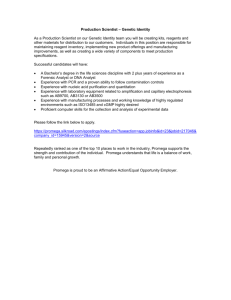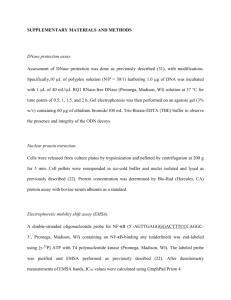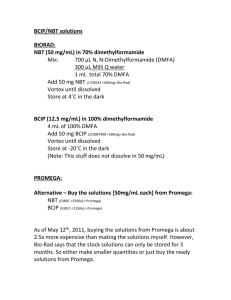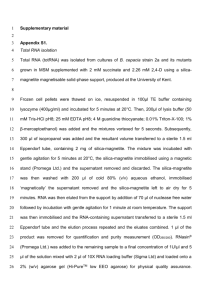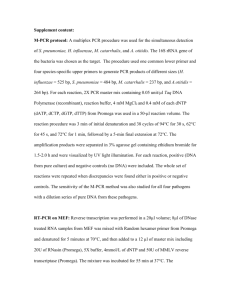DeadEnd Colorimetric TUNEL System Technical Bulletin
advertisement
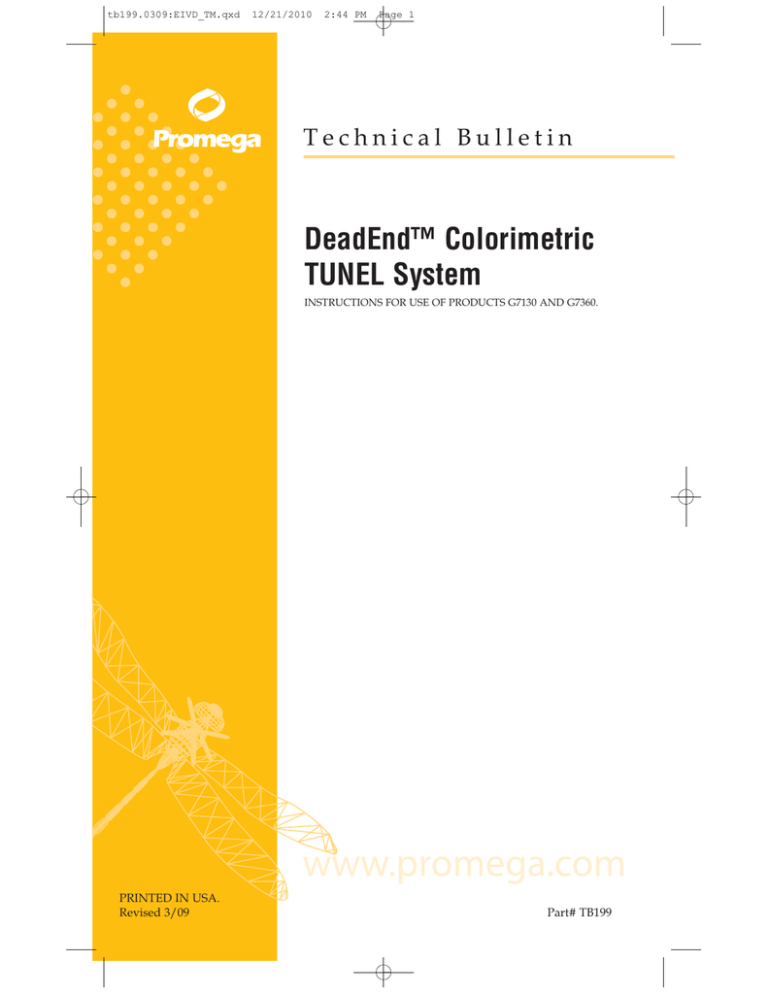
tb199.0309:EIVD_TM.qxd 12/21/2010 2:44 PM Page 1 Technical Bulletin DeadEnd™ Colorimetric TUNEL System INSTRUCTIONS FOR USE OF PRODUCTS G7130 AND G7360. PRINTED IN USA. Revised 3/09 Part# TB199 tb199.0309:EIVD_TM.qxd 12/21/2010 2:44 PM Page 1 DeadEnd™ Colorimetric TUNEL System All technical literature is available on the Internet at www.promega.com/tbs Please visit the web site to verify that you are using the most current version of this Technical Bulletin. Please contact Promega Technical Services if you have questions on use of this system. E-mail techserv@promega.com. 1. Description..........................................................................................................1 2. Product Components and Storage Conditions ............................................3 3. Assay Protocol ....................................................................................................4 A. B. C. D. E. Protocol Overview................................................................................................4 Procedure for the Analysis of Apoptosis in Tissue Sections .........................5 Procedure for the Detection of Apoptosis in Cultured Cells ........................7 Procedure for DNase Treatment of Positive Controls (optional) .................8 Procedure for Anisomycin-Induced Apoptosis in HL-60 Cells ....................9 4. Troubleshooting.................................................................................................9 5. Composition of Buffers and Solutions .......................................................10 6. Related Products ..............................................................................................10 7. References .........................................................................................................12 1. Description The DeadEnd™ Colorimetric TUNEL System is a non-radioactive system designed to provide simple, accurate and rapid detection of apoptotic cells in situ at the single-cell level. The system can be used to assay apoptotic cell death in both tissue sections and cultured cells by measuring nuclear DNA fragmentation, an important biochemical indicator of apoptosis in many cell types. Most cells from higher eukaryotes have the ability to self-destruct by activation of an intrinsic cellular suicide program referred to as programmed cell death or apoptosis (1,2). Apoptosis is important in development, homeostasis and several diseases (2–5). It is characterized by certain morphological features, including membrane blebbing, nuclear and cytoplasmic shrinkage and chromatin condensation. Cells undergoing apoptosis fragment into membranebound apoptotic bodies that are readily phagocytosed and digested by macrophages or neighboring cells without generating an inflammatory response. This is in contrast to the type of cell death known as necrosis, which is characterized by cell swelling, chromatin flocculation, loss of membrane integrity, cell lysis and generation of a local inflammatory reaction. Promega Corporation · 2800 Woods Hollow Road · Madison, WI 53711-5399 USA Toll Free in USA 800-356-9526 · Phone 608-274-4330 · Fax 608-277-2516 · www.promega.com Printed in USA. Revised 3/09 Part# TB199 Page 1 tb199.0309:EIVD_TM.qxd 12/21/2010 2:44 PM Page 2 The morphological changes observed in the nucleus of apoptotic cells are, in part, due to the generation of DNA fragments through the action of endogenous endo-nucleases (6,7). Typically, the DNA of apoptotic cells is cleaved to a population of multimers of 180–200bp fragments, readily observed as a ladder on agarose gels. Apoptotic cells have been clearly labeled in vibratome sections of rat brain after axotomy-induced neuronal death in the lateral geniculate nucleus (LGN) (8–10), in Jurkat cells after anti-Fas treatment (9–11), and in HL-60 cells after anisomycin treatment (12). The DeadEnd™ Colorimetric TUNEL System labels fragmented DNA in situ and has been tested in all of these systems. This Technical Bulletin includes protocols for detecting apoptosis in both tissue sections (Section 3.B) and in anisomycin-induced HL-60 cells (Sections 3.C–E). Assay Principle The DeadEnd™ Colorimetric TUNEL System end-labels the fragmented DNA of apoptotic cells using a modified TUNEL assay. Biotinylated nucleotide is incorporated at the 3´-OH DNA ends using the Terminal Deoxynucleotidyl Transferase, Recombinant, (rTdT) enzyme. Horseradish peroxidase-labeled streptavidin (Streptavidin HRP) is then bound to these biotinylated nucleotides, which are detected using the peroxidase substrate, hydrogen peroxide, and the stable chromogen, diaminobenzidine (DAB). Using this procedure, apoptotic nuclei are stained dark brown. Promega Corporation · 2800 Woods Hollow Road · Madison, WI 53711-5399 USA Toll Free in USA 800-356-9526 · Phone 608-274-4330 · Fax 608-277-2516 · www.promega.com Part# TB199 Page 2 Printed in USA. Revised 3/09 tb199.0309:EIVD_TM.qxd 2. 12/21/2010 2:44 PM Page 3 Product Components and Storage Conditions Product DeadEnd™ Colorimetric TUNEL System Includes: • 9.6ml Equilibration Buffer • 40µl Biotinylated Nucleotide Mix (2 × 20µl) •2 × 20µl Terminal Deoxynucleotidyl Transferase, Recombinant • 70ml SSC, 20X • 10mg Proteinase K Product DeadEnd™ Colorimetric TUNEL System Includes: • 4.8ml Equilibration Buffer • 20µl Biotinylated Nucleotide Mix • 20µl Terminal Deoxynucleotidyl Transferase, Recombinant • 20ml SSC, 20X • 10mg Proteinase K Size 40 reactions • • • • • 40µl Streptavidin HRP (0.5mg/ml) 200µl DAB 20X Chromogen 200µl DAB Substrate 20X Buffer 200µl Hydrogen Peroxide 20X 40 Plastic Coverslips (2 × 20) Size 20 reactions • • • • • Cat.# G7130 Cat.# G7360 40µl Streptavidin HRP (0.5mg/ml) 200µl DAB 20X Chromogen 200µl DAB Substrate 20X Buffer 200µl Hydrogen Peroxide 20X 20 Plastic Coverslips Storage Conditions: Store the Equilibration Buffer, rTdT Enzyme, Biotinylated Nucleotide Mix and Proteinase K at –20°C. Store the Streptavidin HRP, DAB 20X Chromogen, DAB Substrate 20X Buffer and Hydrogen Peroxide 20X at 4°C. Store the 20X SSC and Plastic Coverslips at room temperature. ! Different components of the system have different storage conditions. Reconstitute the Proteinase K supplied with the system in 1ml of proteinase K buffer (see Section 5) before use. Store aliquots of this reconstituted 10mg/ml Proteinase K solution at –20°C, where the enzyme is stable for at least 6 months. Safety Considerations: The Equilibration Buffer contains potassium cacodylate (dimethylarsinic acid). Avoid contact with skin and eyes. Wear gloves and safety glasses when working with this reagent. DAB is a suspected carcinogen. Wear gloves and safety glasses when working with this reagent. Promega Corporation · 2800 Woods Hollow Road · Madison, WI 53711-5399 USA Toll Free in USA 800-356-9526 · Phone 608-274-4330 · Fax 608-277-2516 · www.promega.com Printed in USA. Revised 3/09 Part# TB199 Page 3 tb199.0309:EIVD_TM.qxd 3. 12/21/2010 2:44 PM Page 4 Assay Protocol 3.A. Protocol Overview Please read the material below before using the DeadEnd™ Colorimetric TUNEL System in your application. Materials to Be Supplied by the User (Solution compositions are provided in Section 5.) • phosphate buffered saline (PBS) • 0.3% hydrogen peroxide for blocking endogeneous peroxidases • fixative (e.g., 10% buffered formalin, 4% paraformaldehyde, 4% methanol-free formaldehyde) • mounting medium ! Do not use the Hydrogen Peroxide 20X provided with the system to prepare the 0.3% hydrogen peroxide solution for blocking endogenous peroxidases. Additional Materials for Cultured Cells • poly-L-lysine • 0.2% Triton® X-100 solution in PBS • DNase I (e.g., RQ1 RNase-Free DNase, Cat.# M6101) • DNase buffer Additional Materials for Paraffin-Embedded Tissue Sections • xylene or xylene substitute [e.g., Hemo-De® Clearing Agent (Fisher Cat.# 15-182-507A)] • ethanol (100%, 95%, 85%, 70% and 50%) diluted in deionized water • 0.85% NaCl solution • proteinase K buffer • DNase I (e.g., RQ1 RNase-Free DNase, Cat.# M6101) • DNase buffer Additional Equipment for Tissue Sections and Cultured Cells • poly-L-lysine-coated or silanized microscope slides, [e.g., Poly-Prep® Slides (Sigma Cat.# P 0425), Superfrost® Plus Glass Slides (Fisher Cat.# 12-550-15) or other appropriate pretreated slides] • Coplin jars (a separate jar is needed for optional DNase I positive-control slides) • forceps • humidified chambers for microscope slides • 37°C incubator • micropipettors • glass coverslips • clear nail polish or rubber cement • microscope Promega Corporation · 2800 Woods Hollow Road · Madison, WI 53711-5399 USA Toll Free in USA 800-356-9526 · Phone 608-274-4330 · Fax 608-277-2516 · www.promega.com Part# TB199 Page 4 Printed in USA. Revised 3/09 tb199.0309:EIVD_TM.qxd 12/21/2010 2:44 PM Page 5 3.B. Procedure for the Analysis of Apoptosis in Tissue Sections This procedure is suitable for tissue sections prepared in a variety of ways, including paraffin-embedded sections, frozen sections and vibratome sections. For frozen and vibratome sections, begin at Step 4. 1. For paraffin-embedded sections, deparaffinize tissue sections (attached to microscope slides) by immersing the slides in fresh xylene in a Coplin jar for 5 minutes at room temperature. Repeat. 2. Wash by immersing the slides in 100% ethanol for 5 minutes at room temperature in a Coplin jar. 3. Repeat the 100% ethanol wash for 3 minutes, and then rehydrate the samples by sequentially immersing the slides through graded ethanol washes (95%, 85%, 70% and 50%) for 3 minutes each at room temperature. 4. Wash by immersing the slides in 0.85% NaCl for 5 minutes at room temperature. 5. Wash by immersing the slides in PBS for 5 minutes at room temperature. 6. Fix the tissue sections by immersing the slides in 4% paraformaldehyde solution or 10% buffered formalin in PBS for 15 minutes at room temperature. 7. Immerse the slides in PBS for 5 minutes at room temperature. Repeat. 8. Remove the liquid from the tissue and place the slides on a flat surface. Prepare a 20µg/ml Proteinase K solution from the 10mg/ml Proteinase K stock solution (Section 2) by diluting 1:500 in PBS. Add 100µl of the 20µg/ml Proteinase K solution to each slide to cover the tissue section and incubate slides for 10–30 minutes at room temperature. ! Proteinase K helps permeabilize tissues, but prolonged incubation may cause sections to come off the slide. For best results, optimize the length of incubation. Use shorter incubations for thin tissue sections (e.g., 5–10µm paraffin sections) and longer incubations for thick sections (e.g., 50µm vibratome sections). 9. Wash by immersing the slides in PBS for 5 minutes at room temperature in a Coplin jar. 10. Refix the tissue sections after washing by immersing the slides in 4% paraformaldehyde solution or 10% buffered formalin in PBS for 5 minutes at room temperature. 11. Wash by immersing the slides in PBS for 5 minutes at room temperature. Repeat. Note: If required (Step 11), prepare a positive control by treating a sample with DNase I to cause DNA fragmentation. See Section 3.D for a protocol for DNase treatment. Promega Corporation · 2800 Woods Hollow Road · Madison, WI 53711-5399 USA Toll Free in USA 800-356-9526 · Phone 608-274-4330 · Fax 608-277-2516 · www.promega.com Printed in USA. Revised 3/09 Part# TB199 Page 5 tb199.0309:EIVD_TM.qxd 12/21/2010 2:44 PM Page 6 12. Remove excess liquid by tapping the slides. Cover the cells with 100µl of Equilibration Buffer. Equilibrate at room temperature for 5–10 minutes. 13. While the sections are equilibrating, thaw the Biotinylated Nucleotide Mix on ice and prepare sufficient rTdT reaction mix for all experimental and control reactions. Keep on ice. One hundred microliters of reaction mix per slide will adequately cover the section. See Table 1 for details on preparation of rTdT reaction mix. Table 1. Preparation of rTdT Reaction Mix. Buffer Component Equilibration Buffer Biotinylated Nucleotide Mix rTdT Enzyme Component Volume per Standard 100µl Reaction Number of Reactions (Experimental reactions + Optional Positive Controls) Component Volume 98µl × _____ = _____µl 1µl × _____ = _____µl 1µl × _____ = _____µl For negative controls: Prepare a control incubation buffer without rTdT Enzyme by combining 98µl of Equilibration Buffer, 1µl of Biotinylated Nucleotide Mix and 1µl of autoclaved, deionized water. Process through Steps 14–24, below. 14. Blot around the equilibrated areas with tissue paper and add 100µl of rTdT reaction mix to the sections on a slide. Do not allow the sections to dry. 15. Cover the sections with Plastic Coverslips to ensure even distribution of the reagent. Incubate the slides at 37°C for 60 minutes inside a humidified chamber to allow the end-labeling reaction to occur. 16. Dilute the 20X SSC 1:10 with deionized water. Remove the Plastic Coverslips and terminate the reactions by immersing the slides in 2X SSC in a Coplin jar for 15 minutes at room temperature. Note: Ensure that all salts of the 20X SSC are in solution before diluting. 17. Wash by immersing the slides in fresh PBS for 5 minutes at room temperature. Repeat this wash twice to remove unincorporated biotinylated nucleotides. 18. Block the endogenous peroxidases by immersing the slides in 0.3% hydrogen peroxide in PBS for 3–5 minutes at room temperature. ! Do not use the Hydrogen Peroxide 20X provided with the system to prepare the 0.3% hydrogen peroxide solution for blocking endogenous peroxidases. Promega Corporation · 2800 Woods Hollow Road · Madison, WI 53711-5399 USA Toll Free in USA 800-356-9526 · Phone 608-274-4330 · Fax 608-277-2516 · www.promega.com Part# TB199 Page 6 Printed in USA. Revised 3/09 tb199.0309:EIVD_TM.qxd 12/21/2010 2:44 PM Page 7 19. Wash by immersing the slides in PBS for 5 minutes at room temperature. Repeat twice. 20. Dilute the Streptavidin HRP solution 1:500 in PBS. Add 100µl to each slide and incubate for 30 minutes at room temperature. 21. Wash by immersing the slides in PBS for 5 minutes at room temperature. Repeat twice. 22. Combine the DAB components just prior to use. Add 50µl of the DAB Substrate 20X Buffer to 950µl deionized water. Then add 50µl of the DAB 20X Chromogen and 50µl of Hydrogen Peroxide 20X. Add 100µl of DAB solution to each slide and develop until there is a light brown background (typically approximately 10 minutes, but the time may need to be optimized). Do not allow the background to become too dark. ! Keep the DAB solution away from light and use within 30 minutes. 23. Rinse several times in deionized water. 24. Mount slides in an aqueous or permanent mounting medium [e.g., 100% glycerol or Permount® Mounting Medium (Fisher Cat.# SP15-100)]. For the aqueous mounting medium, seal the edges of the coverslip with nail polish. Use a light microscope to observe staining. III.C. Procedure for the Detection of Apoptosis in Cultured Cells Prepare sufficient poly-L-lysine-coated slides for all experimental samples and controls. Preparation of Poly-L-Lysine-Coated Slides Pipette an aqueous solution of poly-L-lysine (Sigma Cat.# P 8920, diluted 1:10 in water) onto the surface of each precleaned glass slide. Distribute a thin layer of the poly-L-lysine solution throughout the areas to be used for fixing cells. Immediately after the slides have dried, rinse in deionized water and then allow the coated slides to air-dry for 30–60 minutes. Poly-L-lysine-coated slides may be stored at 4°C for 7 days before use. To grow adherent cells on poly-L-lysine-coated slides, use poly-L-lysine without preservative (Sigma Cat.# P 9155). Preparation of Cells on Slides Centrifuge control or apoptosis-induced cells, wash in PBS, resuspend and add to the poly-L-lysine-coated slides. Let the cells air-dry in a tissue culture hood for approximately 15 minutes before fixing. Alternatively, grow adherent cells on Lab-Tek® Chamber Slides. Following control or experimental treatment to induce apoptosis, wash the slides twice with PBS and process directly in the apoptosis detection assay follows. Promega Corporation · 2800 Woods Hollow Road · Madison, WI 53711-5399 USA Toll Free in USA 800-356-9526 · Phone 608-274-4330 · Fax 608-277-2516 · www.promega.com Printed in USA. Revised 3/09 Part# TB199 Page 7 tb199.0309:EIVD_TM.qxd 12/21/2010 2:44 PM Page 8 Apoptosis Detection 1. Fix cells by immersing slides in 10% buffered formalin, 4% paraformaldehyde solution or 10% buffered formalin in PBS in a Coplin jar for 25 minutes at room temperature. 2. Wash by immersing in fresh PBS for 5 minutes at room temperature. Repeat. Note: After completion of Step 2, slides may be stored in PBS at 4°C or in 70% ethanol at –20°C. 3. Permeabilize cells by immersing the slides in 0.2% Triton® X-100 solution in PBS for 5 minutes at room temperature. 4. Rinse slides by immersing in fresh PBS for 5 minutes at room temperature. Repeat. 5. Follow Section 3.B, Steps 12–24. An optional positive control slide may be prepared at this point as described in Section 3.D. 3.D. Procedure for DNase Treatment of Positive Controls (optional) A positive control for detection of DNA fragmentation may be included in each experiment. For cultured cells, follow Steps 1–4 as described in Section 3.C. After Step 4, prepare a positive control slide by treating the cells with DNase I (not included with the system) as described below. Note: DNase I treatment of the fixed cells results in fragmentation of the chromosomal DNA and exposure of multiple 3´-OH DNA ends at which Biotinylated Nucleotides can be incorporated. The protocol outlined below generally results in the majority of the treated cells demonstrating peroxidase labeling. ! Use a separate Coplin jar for positive control slides. Residual DNase I activity from the positive control slide may introduce high background to the experimental slides. 1. Add 100µl of DNase I buffer (Section 5) to the fixed cells and incubate at room temperature for 5 minutes. 2. Tap off the liquid and add 100µl of DNase I buffer containing 5–10unit/ml of DNase I (Cat.# M6101, RQ1 RNase-free DNase; when using other DNases an optimization step may be required). Incubate for 10 minutes at room temperature. 3. Remove excess liquid by tapping the slide, and wash the slide extensively 3–4 times in deionized water in a Coplin jar dedicated for the positive control. 4. Wash by immersing the slides in PBS for 5 minutes at room temperature. 5. Process the positive control as described in Section 3.B, Steps 12–24, using separate Coplin jars. Promega Corporation · 2800 Woods Hollow Road · Madison, WI 53711-5399 USA Toll Free in USA 800-356-9526 · Phone 608-274-4330 · Fax 608-277-2516 · www.promega.com Part# TB199 Page 8 Printed in USA. Revised 3/09 tb199.0309:EIVD_TM.qxd 12/21/2010 2:44 PM Page 9 3.E. Procedure for Anisomycin-Induced Apoptosis in HL-60 Cells Treatment with the protein synthesis inhibitor anisomycin induces apoptosis in the human promyelocytic cell line HL-60 (10). 1. Grow HL-60 cells in RPMI-1640 medium containing 10% fetal bovine serum in a humidified 5% CO2 incubator at 37°C. 2. Adjust the cell density to 5 × 105 cells/ml and treat with anisomycin at a final concentration of 2µg/ml (dissolved in DMSO). Incubate for 2 hours in a humidified 5% CO2 incubator at 37°C. Treat negative control cells with an equal volume of DMSO and incubate under the same conditions. 3. Harvest the cells and resuspend in PBS to 1.5 x 106 cells/ml before adding a thin layer to the poly-L-lysine-coated slides. Then follow Steps 1–5 as described in Section 3.C for the analysis of apoptosis. 4. Troubleshooting For questions not addressed here, please contact your local Promega Branch Office or Distributor. Contact information available at: www.promega.com. E-mail: techserv@promega.com Symptoms Causes and Comments High background (i.e., strong staining of nonapoptotic cells) Nonspecific incorporation of biotinylated nucleotides. Do not allow cells to dry out. At Section 3.B, Step 17, slides may be washed 3 times for 5 minutes with PBS containing 0.1% Triton® X-100 and 5mg/ml BSA, followed by a single PBS wash step to remove nonspecific background. DNA degraded during tissue preparation. Make sure that tissue samples are fixed or frozen promptly. High general background Sample incubated too long with DAB solution. Decrease DAB development time. Endogenous peroxidases not blocked. Increase blocking time with 0.3% hydrogen peroxide. Little or poor staining Insufficient permeabilization with Triton® X-100 or Proteinase K. Optimize permeabilization step by adjusting the incubation time with the permeabilization agent. Loss of tissue section from slide Tissue section enzymatically digested from slide. Decrease Proteinase K incubation time. Promega Corporation · 2800 Woods Hollow Road · Madison, WI 53711-5399 USA Toll Free in USA 800-356-9526 · Phone 608-274-4330 · Fax 608-277-2516 · www.promega.com Printed in USA. Revised 3/09 Part# TB199 Page 9 tb199.0309:EIVD_TM.qxd 5. 12/21/2010 2:44 PM Page 10 Composition of Buffers and Solutions 1X PBS (pH 7.4) DNase I buffer 137mM 2.68mM 1.47mM 8.1mM 40mM 10mM 6mM 10mM NaCl KCl KH2PO4 Na2HPO4 20X SSC 87.7g NaCl 44.1g sodium citrate Dissolve in 400ml of deionized water. Adjust pH to 7.2 with 10N NaOH and bring volume to 500ml. 2X SSC Dilute 20X SSC 1:10 with deionized water before use. Tris-HCl (pH 7.9) NaCl MgCl2 CaCl2 Equilibration Buffer 200mM potassium cacodylate (pH 6.6 at 25°C) 25mM Tris-HCl (pH 6.6 at 25°C) 0.2mM DTT 0.25mg/ml BSA 2.5mM cobalt chloride proteinase K buffer 100mM Tris-HCl (pH 8.0) 50mM EDTA 4% paraformaldehyde solution Weigh out 4g paraformaldehyde in a fume hood, add PBS and bring to 100ml. Dissolve by heating the closed bottle in a water bath at 65°C for 2 hours. Store the solution at 4°C, where it is stable for at least 2 weeks. 6. Related Products Product Caspase-Glo® 3/7 Assay* Caspase-Glo® 8 Assay* Caspase-Glo® 9 Assay* Apo-ONE® Homogeneous Caspase-3/7 Assay Size 2.5ml 10ml 100ml 2.5ml 10ml 100ml 2.5ml 10ml 100ml 10ml 100ml Cat.# G8090 G8091 G8092 G8200 G8201 G8202 G8210 G8211 G8212 G7790 G7791 *For Laboratory Use. Promega Corporation · 2800 Woods Hollow Road · Madison, WI 53711-5399 USA Toll Free in USA 800-356-9526 · Phone 608-274-4330 · Fax 608-277-2516 · www.promega.com Part# TB199 Page 10 Printed in USA. Revised 3/09 tb199.0309:EIVD_TM.qxd 12/21/2010 2:44 PM Page 11 Product DeadEnd™ Fluorometric TUNEL System CaspACE™ Assay System, Colorimetric* Size 60 reactions 50 assays 100 assays 160 assays 50µl 125µl 50µl 125µl 100µl 50µl 50µl 100µg 10ml 10 × 10ml 100ml 10 × 100ml 20ml 100ml 10 × 100ml Cat.# G3250 G7351 G7220 G3540 G7461 G7462 G7231 G7232 G5961 G7481 G7341 G7421 G7570 G7571 G7572 G7573 G8080 G8081 G8082 200 assays 1,000 assays 5,000 assays G3582 G3580 G3581 1,000 assays 5,000 assays 50,000 assays 250mg G5421 G5430 G5440 G1112 1g G1111 1,000 assays 5,000 assays G4000 G4100 200–800 assays 1,000–4,000 assays CytoTox 96® Non-Radioactive Cytotoxicity Assay* 1,000 assays rhTNF-α 10µg RQ1 RNase-Free DNase* 1,000u Terminal Deoxynucleotidyl Transferase, Recombinant* 300u G7890 G7891 G1780 G5241 M6101 M1871 CaspACE™ Assay System, Fluorometric* CaspACE™ FITC-VAD-FMK In Situ Marker Caspase Inhibitor Z-VAD-FMK Caspase Inhibitor Ac-DEVD-CHO Anti-ACTIVE® Caspase-3 pAb Anti-PARP p85 Fragment pAb Anti-Cytochrome c mAb CellTiter-Glo® Luminescent Cell Viability Assay CellTiter-Blue® Cell Viability Assay CellTiter 96® AQueous One Solution Cell Proliferation Assay* CellTiter 96® AQueous Non-Radioactive Cell Proliferation Assay* CellTiter 96® AQueous MTS Reagent Powder* CellTiter 96® Non-Radioactive Cell Proliferation Assay* CytoTox-ONE™ Homogeneous Membrane Integrity Assay *For Laboratory Use. Promega Corporation · 2800 Woods Hollow Road · Madison, WI 53711-5399 USA Toll Free in USA 800-356-9526 · Phone 608-274-4330 · Fax 608-277-2516 · www.promega.com Printed in USA. Revised 3/09 Part# TB199 Page 11 tb199.0309:EIVD_TM.qxd 7. 12/21/2010 2:44 PM Page 12 References 1. Ellis, R.E., Yuan, J.Y. and Horvitz, H.R. (1991) Mechanisms and functions of cell death. Annu. Rev. Cell. Biol. 7, 663–98. 2. Steller, H. (1995) Mechanisms and genes of cellular suicide. Science 267, 1445–9. 3. Burek, M.J. and Oppenheim, R.W. (1996) Programmed cell death in the developing nervous system. Brain Pathol. 6, 427–46. 4. Johnson, E.M. Jr., Deckwerth, T.L. and Deshmukh, M. (1996) Neuronal death in developmental models: Possible implications in neuropathology. Brain Pathol. 6, 397–409. 5. Cohen, J.J. et al. (1992) Apoptosis and programmed cell death in immunity. Annu. Rev. Immunol. 10, 267–93. 6. Arends, M.J., Morris, R.G. and Wyllie, A.H. (1990) Apoptosis. The role of the endonuclease. Amer. J. Path. 136, 593–608. 7. Gavrieli, Y., Sherman, Y. and Ben-Sasson, S.A. (1992) Identification of programmed cell death in situ via specific labeling of nuclear DNA fragmentation. J. Cell. Biol. 119, 493–501. 8. Agarwala, S. and Kalil, R.E. (1998) Axotomy-induced neuronal death and reactive astrogliosis in the lateral geniculate nucleus following a lesion of the visual cortex in the rat. J. Comp. Neurol. 392, 252–63. 9. Review Article (1998) DeadEnd™ Colorimetric Apoptosis Detection System: Applications in Pathology. Neural Notes 12, 5–8. 10. O’Brien, et al. (1998) DeadEnd™ Colorimetric Apoptosis Detection System: Applications in Pathology. Promega Notes 69, 2–5. 11. Weis, M. et al. (1995) Cellular events in Fas/APO-1-mediated apoptosis in JURKAT T lymphocytes. Exp. Cell Res. 219, 699–708. 12. Polverino, A.J. and Patterson, S.D. (1997) Selective activation of caspases during apoptotic induction in HL-60 cells. J. Biol. Chem. 272, 7013–21. © 1998–2005, 2009 Promega Corporation. All Rights Reserved. Anti-ACTIVE, Apo-ONE, Caspase-Glo, CellTiter 96, CellTiter-Blue, CellTiter-Glo and CytoTox 96 are registered trademarks of Promega Corporation. CaspACE, CytoTox-ONE and DeadEnd are trademarks of Promega Corporation. Hemo-De is a registered trademark of Scientific Safety Solvents. Lab-Tek is a registered trademark of Nalge Nunc International. Permount is a registered trademark of Fisher Scientific Company. Poly-Prep is a registered trademark of BioRad Laboratories, Inc. Superfrost is a registered trademark of Erie Scientific. Triton is a registered trademark of Union Carbide Chemicals & Plastics Technology Corporation. Products may be covered by pending or issued patents or may have certain limitations. Please visit our Web site for more information. All prices and specifications are subject to change without prior notice. Product claims are subject to change. Please contact Promega Technical Services or access the Promega online catalog for the most up-to-date information on Promega products. Promega Corporation · 2800 Woods Hollow Road · Madison, WI 53711-5399 USA Toll Free in USA 800-356-9526 · Phone 608-274-4330 · Fax 608-277-2516 · www.promega.com Part# TB199 Page 12 Printed in USA. Revised 3/09
